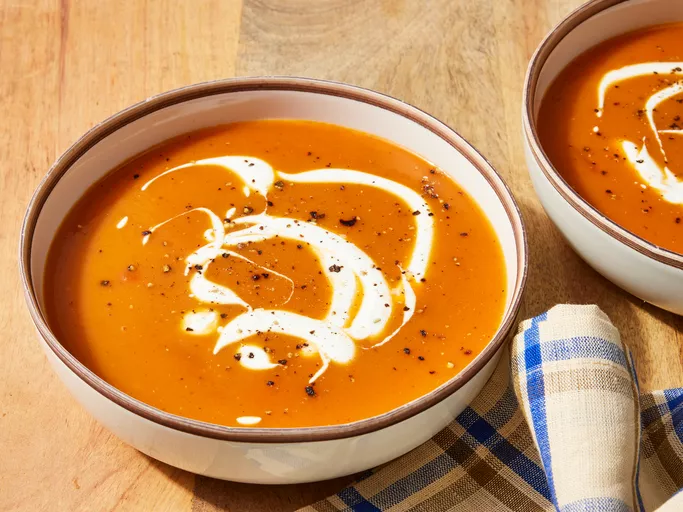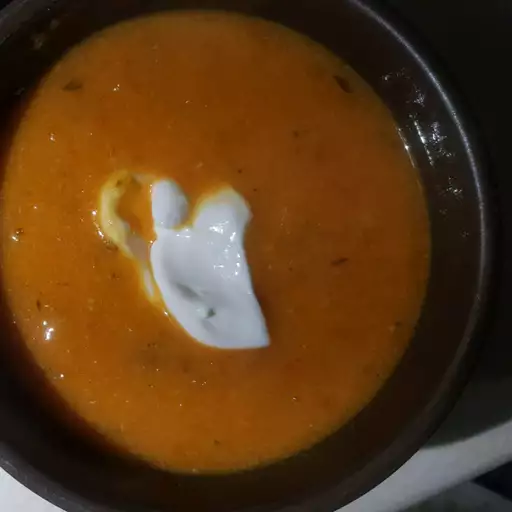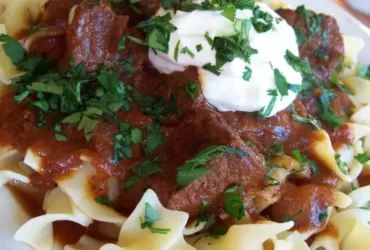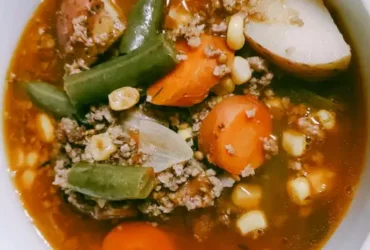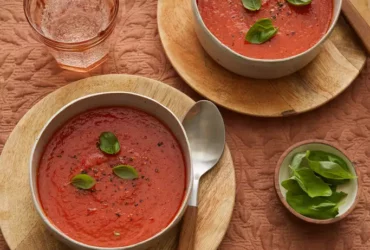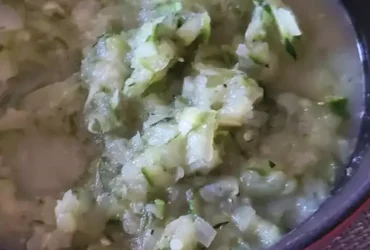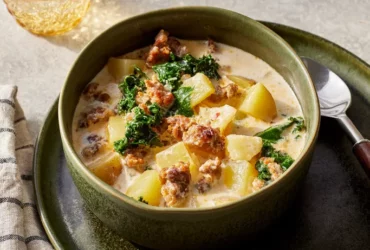Ingredients
Essential Ingredients
The ingredients that make up a delicious Roasted Red Pepper and Tomato Soup are essential to its flavor and texture.
First and foremost, you will need tomatoes as the base ingredient for this soup. Fresh or canned, they provide a rich, tangy taste that is quintessential to this recipe.
You will also require red bell peppers (or red capsicum) to add a sweet, slightly smoky flavor and a vibrant color to your dish.
For added depth and complexity, it’s recommended to use onion and garlic, which are sautéed in oil until softened before being added to the soup pot.
A pinch of salt enhances the flavors, while a few sprigs of fresh basil add an herbal note that complements the sweetness of the peppers.
You can also use olive oil as your cooking medium for this recipe, which lends itself well to Mediterranean-inspired dishes like this one.
Other essential ingredients include black pepper, a pinch of nutmeg or cayenne pepper (optional) to add heat, and finally, a splash of milk or cream to give the soup its creamy texture.
4 large red bell peppers
The four large red bell peppers used in this recipe play a crucial role in adding flavor, texture, and vibrant color to the Roasted Red Pepper and Tomato Soup.
When selecting the right red bell peppers for this dish, it is essential to choose ones that are firm, heavy for their size, and have a glossy appearance. Avoid peppers with soft spots, wrinkles, or signs of mold.
Characteristics of Ideal Red Bell Peppers
- Crisp flesh: The ideal red bell pepper should have crisp flesh that gives way to the slightest pressure, indicating a high water content and a sweet flavor.
- Sweet aroma: The peppers should emit a pleasant, slightly sweet aroma when scratched or bruised. This is an indication of their ripeness and sweetness.
- Deep red color: A deep red color with no signs of green or yellow indicates that the pepper has reached its full maturity and has developed its characteristic sweetness and flavor.
The four large red bell peppers called for in this recipe can be used in a variety of ways throughout the soup-making process. They can be roasted to add depth and smokiness, pureed to create a smooth texture, or diced to add a pop of color and crunch.
3 pounds of ripe tomatoes, cored and chopped
The ingredient that takes center stage in this recipe is the humble tomato – specifically 3 pounds of ripe tomatoes, cored and chopped. The key to selecting the perfect tomatoes lies in their ripeness. A ripe tomato should be slightly soft to the touch and have a rich, deep red color.
When choosing tomatoes for roasting, look for varieties that are sweet and flavorful. Some popular options include beefsteak, Roma, or even cherry tomatoes. The type of tomato used will affect the final flavor profile of the soup, so don’t be afraid to experiment with different varieties.
Coring and chopping the tomatoes is a crucial step in preparing them for roasting. To core a tomato, simply cut out the stem end and then slice the tomato in half around its middle. This will help remove the seeds and excess water from the tomato, making it easier to roast and reducing the risk of a watery soup.
To chop the tomatoes, aim for rough 1-inch pieces. Don’t worry too much about precision – you want the pieces to be roughly the same size so they cook evenly during roasting. You should end up with around 3 pounds of chopped tomatoes once you’ve finished coring and chopping them all.
Now that your tomatoes are prepped, it’s time to start thinking about the other ingredients in this recipe – specifically the roasted red peppers! Stay tuned for a more detailed look at those later on.
1 tablespoon olive oil
Olive oil is a fundamental ingredient in many culinary traditions, including the Roasted Red Pepper and Tomato Soup Recipe. It serves as the primary cooking medium for sautéing aromatics and providing a rich flavor profile to the dish.
When it comes to selecting olive oil, it’s essential to choose a high-quality oil that complements the natural flavors of the red peppers and tomatoes. Look for an extra virgin or pure olive oil that is extracted from the first pressing of olives.
The health benefits of olive oil are well-documented, making it an excellent choice for cooking and dressing salads. Rich in monounsaturated fats, olive oil helps lower cholesterol levels and reduces the risk of heart disease.
One tablespoon of olive oil contains approximately 120 calories and a balance of vitamins A and E. It’s also an excellent source of antioxidants, which help protect against cell damage and promote overall well-being.
In the context of the Roasted Red Pepper and Tomato Soup Recipe, the one tablespoon of olive oil will be used to sauté the aromatics before adding the roasted red peppers and tomatoes. This step is crucial in releasing the flavors of the vegetables and creating a flavorful base for the soup.
Salt and pepper to taste
Salt and pepper are two fundamental seasonings used to enhance the flavor of various dishes, including the Roasted Red Pepper and Tomato Soup Recipe.
Salt, also known as sodium chloride, is a crystalline compound composed of sodium ions (Na+) and chloride ions (Cl-) in a 1:1 ratio. It is commonly found in nature in the form of halite (rock salt) or in seawater. Salt plays a crucial role in various bodily functions, such as regulating blood pressure, maintaining fluid balance, and facilitating nerve function.
When used as an ingredient in cooking, salt acts as a seasoning, flavor enhancer, and preservative agent. It helps to bring out the natural flavors of other ingredients, reduces bitterness, and adds depth to dishes. In the context of the Roasted Red Pepper and Tomato Soup Recipe, salt can be added towards the end of cooking or even after serving, depending on personal taste preferences.
Pepper, also known as Piper nigrum, is a flowering vine native to India and Southeast Asia. The peppercorns harvested from its berries contain a compound called piperine, which gives them their distinct flavor and aroma. Pepper has been used for centuries in various cultures for medicinal purposes, including digestive aid and pain relief.
In cooking, pepper adds a spicy and warm flavor to dishes, enhancing their overall taste experience. Black pepper is the most commonly used type of pepper in recipes like the Roasted Red Pepper and Tomato Soup Recipe. Its bold flavor pairs well with the sweetness of roasted red peppers and tomatoes, creating a balanced and harmonious flavor profile.
When using salt and pepper to season your soup, it’s essential to remember that their flavors are highly versatile and can be adjusted to individual tastes. Add a pinch or two of each, then taste and adjust accordingly. This allows you to achieve the perfect balance of salty and peppery flavors in your Roasted Red Pepper and Tomato Soup Recipe.
Optional: garlic, onions, or other herbs for added flavor
The base ingredients of this recipe include a variety of fresh vegetables that provide depth and richness to the soup.
For the Roasted Red Pepper and Tomato Soup, you will need the following essential ingredients:
- 2 large red bell peppers, any seeds removed and chopped into 1-inch pieces
- 3 pounds fresh tomatoes, cored and chopped (or 2 cups of diced canned tomatoes)
- 4 tablespoons olive oil
- 2 teaspoons smoked paprika (optional)
- 1 teaspoon salt
- 1/2 teaspoon black pepper
- 4 cups vegetable broth or chicken broth
- For added flavor, you may also consider adding some aromatics to sauté in the pot before adding the other ingredients.
- Garlic: 3-4 cloves, peeled and minced
- Onions: 1 medium onion, chopped (about 2 cups)
- Herbs: fresh oregano or thyme leaves can be used to add a slightly savory flavor
- Some other herbs you might consider adding for extra depth of flavor include bay leaves, rosemary, and parsley.
- When selecting vegetables for this recipe, it’s worth noting that red bell peppers come in a variety of colors including green, yellow, orange, and red.
- Each color may have slightly different levels of sweetness and texture but all should work well in the soup.
Instructions
Premixing and Roasting the Vegetables
To begin with, it’s essential to carefully follow the instructions for roasting the vegetables as they play a crucial role in bringing out their natural sweetness and depth of flavor.
Premixing the Vegetables
Firstly, premixing
the vegetables is a vital step that ensures even cooking and distribution of flavors. This involves mixing together the sliced red peppers, halved tomatoes, garlic cloves, and olive oil in a bowl to coat the vegetables evenly.
- Slice the red peppers: Use a sharp knife to slice the red peppers into thin strips, removing any seeds or white membranes.
- Halve the tomatoes: Cut the tomatoes in half and remove any excess liquid from them.
- Mince the garlic cloves: Peel the garlic cloves and mince them finely using a garlic press or a knife.
Add the olive oil: Pour the olive oil over the sliced red peppers, halved tomatoes, minced garlic, salt, and pepper in the bowl. Toss well to coat all the vegetables evenly.Once you have completed premixing, proceed with spreading the vegetable mixture evenly on a baking sheet
lined with parchment paper. This helps prevent the vegetables from sticking and makes cleanup easier.
Roasting the Vegetables
Next, place the baking sheet in a preheated oven at 425°F (220°C) for about 25-30 minutes or until the vegetables are tender and slightly charred. During this time, you may need to gently stir the vegetables halfway through the roasting process to ensure even cooking.
After the vegetables have finished roasting, remove them from the oven and let them cool down slightly before transferring them to a blender or food processor along with any remaining liquid on the baking sheet. This will help extract all the flavors and juices from the roasted vegetables, resulting in a rich and creamy soup.
Final Tips
When roasting the vegetables, keep an eye on them as they can quickly go from perfectly cooked to burnt. It’s also essential to use fresh, high-quality ingredients for the best flavor and texture.
Preheat your oven to 375°F (190°C).
To begin making this delicious Roasted Red Pepper and Tomato Soup, it’s essential to start with a properly preheated oven. This step may seem trivial, but it’s crucial in achieving the perfect results.
The first instruction is to preheat your oven to 375°F (190°C). This temperature is ideal for roasting red peppers and tomatoes, as it allows them to cook slowly and evenly without burning or overcooking. It’s worth noting that this temperature may vary slightly depending on your personal preference for the level of smokiness in your roasted vegetables.
When preheating the oven, ensure that you set it to the correct temperature by checking the display screen. You can also use an oven thermometer to double-check the internal temperature if you’re unsure. This will guarantee that your oven is at the right temperature for cooking.
Once the oven is preheated, you’ll be ready to move on to the next step: roasting the red peppers and tomatoes. This process involves placing the vegetables in a single layer on a baking sheet, drizzling them with olive oil, and sprinkling salt and pepper to taste. Roast the vegetables in the preheated oven for about 30-40 minutes or until they’re tender and lightly charred.
After the vegetables have roasted, you can proceed with the rest of the recipe by peeling the skin off the peppers, removing the seeds from the tomatoes, and blending everything together to create a smooth soup. The preheated oven has played a crucial role in bringing out the natural sweetness in the vegetables, which is essential for achieving the perfect flavor profile.
In summary, preheating your oven to 375°F (190°C) is an essential step in making this Roasted Red Pepper and Tomato Soup recipe. By following this instruction carefully, you’ll be able to unlock the full potential of your ingredients and create a delicious and comforting soup that’s sure to impress.
Cut the bell peppers in half and remove seeds.
To successfully make a delicious Roasted Red Pepper and Tomato Soup, it’s essential to follow these steps carefully.
Cutting and Preparing the Bell Peppers
The first step in creating this mouth-watering soup is to cut the bell peppers in half. This means taking each pepper and bisecting it lengthwise, so that you have two identical halves. It’s crucial to make these cuts carefully, as you want to ensure that they are even and will roast evenly.
Once the bell peppers are cut in half, the next step is to remove their seeds. The seeds of a bell pepper can be quite large and hard, so it’s best to scoop them out with a spoon or use a melon baller to remove them cleanly. This process will not only make your soup more visually appealing but also prevent any bitterness that the seeds may impart.
After removing the seeds from each half of the bell pepper, you can place them on a baking sheet lined with parchment paper. This will make it easier to roast the peppers in the oven and ensure that they don’t stick to the pan.
Other Essential Ingredients
- You’ll also need two cups of chopped fresh tomatoes for this recipe, preferably from your garden or a nearby market.
- Aromatics such as onions, garlic, and celery are essential in this recipe to add depth and complexity to the soup.
- Spices like thyme and oregano will complement the flavors of the bell peppers and tomatoes beautifully.
With all these ingredients ready, you’re just a few steps away from enjoying a warm, comforting bowl of Roasted Red Pepper and Tomato Soup. So go ahead, get cooking!
Place the chopped tomatoes, olive oil, salt, and pepper in a bowl.
Instructions for preparing this delectable Roasted Red Pepper and Tomato Soup Recipe involve several steps that require attention to detail. The first step in this process is to place the chopped tomatoes, olive oil, salt, and pepper in a bowl.
It’s essential to note that before placing these ingredients in the bowl, they should be carefully measured and portioned out according to the recipe’s specifications. This will ensure that the flavors are balanced and the soup turns out rich and savory.
The chopped tomatoes should be firm but not hard, with no signs of spoilage or mold. The olive oil should be extra virgin, chosen for its mild flavor and high nutritional value. Salt and pepper should also be added in measured amounts to enhance the flavors without overpowering them.
Once these ingredients are in the bowl, it’s time to add any additional aromatics or spices that will complement their flavors. This might include minced garlic, onion powder, or dried herbs such as thyme or rosemary.
The bowl itself should be clean and dry, free from any residual flavors or odors that could interfere with the preparation of the soup. A stainless steel or ceramic bowl is ideal for this task, as they can withstand high temperatures without imparting any unwanted flavors to the ingredients.
By following these simple instructions, you’ll be well on your way to preparing a delicious and nourishing Roasted Red Pepper and Tomato Soup that’s perfect for a cold winter’s night or a quick weeknight meal.
Mix gently.
To ensure that you mix the ingredients for the Roasted Red Pepper and Tomato Soup Recipe correctly, follow these guidelines:
Mix gently the roasted red peppers with a spoon or spatula to break them down into smaller pieces. This will help to release their natural sweetness and infuse the soup with their distinctive flavor.
Next, add the diced tomatoes to the bowl or pot containing the roasted red peppers. If using canned tomatoes, be sure to rinse them under cold running water before chopping them up finely. This will help to remove excess salt and any unwanted seasonings that may have been added during processing.
Now, it’s time to combine all of the ingredients for the Roasted Red Pepper and Tomato Soup Recipe. Start by adding the vegetable broth to the bowl or pot, making sure to cover the vegetables evenly with the liquid.
Use a spoon or spatula to gently mix the soup in a slow, sweeping motion. Be careful not to overmix the soup at this stage, as it can become too thick and unappetizing.
If desired, add any additional ingredients such as spices, herbs, or cream to the soup. Then, continue to mix the soup gently until all of the ingredients are fully incorporated and the soup is heated through.
Once the soup has reached your desired temperature and consistency, taste it one last time to adjust the seasoning if necessary. Finally, serve the Roasted Red Pepper and Tomato Soup hot, garnished with a sprinkle of fresh herbs or a dollop of cream for added flavor and visual appeal.
Arrange the bell peppers on a baking sheet lined with parchment paper.
When following a recipe like Roasted Red Pepper and Tomato Soup, it’s crucial to start with precise and clear instructions. The first step in this process involves preparing the bell peppers for roasting, which plays a vital role in bringing out their sweet, smoky flavor and tender texture.
To begin, you need to select some fresh and vibrant bell peppers, preferably with a mix of colors like red, yellow, orange, or green. It’s essential to choose bell peppers that are firm and have no signs of wrinkles or soft spots. You’ll need at least 4-6 bell peppers for this recipe, depending on their size.
Next, preheat your oven to 400°F (200°C). This temperature is crucial in cooking the bell peppers evenly and quickly without burning them. Line a baking sheet with parchment paper, which will prevent the peppers from sticking to the surface and make cleaning up easier.
Now, carefully place each bell pepper on the prepared baking sheet, leaving about 1 inch of space between them. You can arrange them in a single layer or slightly overlap them for even cooking. Make sure they’re not touching each other directly, as this could cause them to steam instead of roast.
Once your bell peppers are arranged on the baking sheet, place it in the preheated oven and bake for about 30-40 minutes or until their skin is blistered and charred. You can check on them after 20-25 minutes to rotate the peppers for even cooking.
After the bell peppers have finished roasting, remove them from the oven and let them cool down slightly before peeling off their skin. This step is crucial in achieving that smooth and silky texture in your soup.
Roast for about 30 minutes or until the skin blisters.
To complete this task, follow these detailed instructions on how to roast red peppers for the soup recipe.
Roasting Red Peppers
- Preheat your oven to a high temperature of around 425-450°F (220-230°C).
- Place one or two whole red bell peppers on a baking sheet lined with parchment paper.
- Drizzle a small amount of olive oil over the peppers, making sure they are lightly coated.
- Season with salt to taste and any other herbs you like (such as garlic powder or dried oregano).
Roasting Process
Roast for about 30 minutes or until the skin blisters.
Here’s how to check if it’s ready: when the peppers are tender and charred, their skin will start to blister. This should happen within the 30-minute mark.
Removing the Skin
- Once you’ve removed the roasted peppers from the oven, let them cool in a bowl covered with plastic wrap for about 10-15 minutes.
- The steam from the cooled peppers will help loosen the skin, making it easier to remove.
Removing and Discarding the Skin
After cooling the peppers in a bowl covered with plastic wrap, peel off the skin under cold running water. This should come off easily now that the skin has been loosened by the steam.
Cutting Up the Peppers
- Once you’ve removed all the skin from both peppers (if you’re using two), cut them up into large chunks or pieces that can be easily pureed in a blender or food processor.
Add to Soup
The roasted red peppers are now ready to be added to your Roasted Red Pepper and Tomato Soup Recipe! Simply add the chopped pepper to your pot of simmering soup and enjoy the flavorful combination of roasted red peppers and tomatoes!
Blending and Serving
- In order to create a delicious and smooth roasted red pepper and tomato soup, it’s essential to follow proper instructions for blending and serving.
- The first step in blending the ingredients is to ensure that they are cool enough to handle without burning yourself.
- This can be achieved by allowing the mixture to rest for at least 10-15 minutes after cooking.
- Next, transfer the soup into a blender or food processor and blend it on high speed until smooth and creamy.
- It’s crucial to blend in batches if necessary, as overloading the blender can result in spills and messes.
- If you’re using an immersion blender, be sure to hold it firmly against the bottom of the pot to prevent splashing.
- Once the soup is smooth, return it to the pot and reheat it gently on low heat if necessary.
- To serve the roasted red pepper and tomato soup, ladle it into bowls and garnish with fresh herbs or a dollop of cream, if desired.
- You can also add some crusty bread or croutons on top for added texture and flavor.
- Consider serving this delicious soup as an appetizer or main course, paired with a side salad or sandwich for a well-rounded meal.
- For an extra-special touch, drizzle the soup with a swirl of olive oil or cream to add richness and depth to the flavors.
- Remember to serve immediately after reheating, and enjoy the ooohs and aaahs from your family and friends as they take their first sip of this mouthwatering roasted red pepper and tomato soup!
Once done, peel off the skin of the bell peppers.
When working with ingredients for a recipe like Roasted Red Pepper and Tomato Soup, following precise instructions is crucial to achieving the desired flavors and textures.
The step involving peeling off the skin of the bell peppers requires attention to detail, as it significantly impacts the overall taste and appearance of the final product.
Initially, you will need to place the bell peppers on a baking sheet lined with parchment paper. Preheat your oven to 425°F (220°C) for this step. Roasting the peppers in the preheated oven at 425°F (220°C) brings out their natural sweetness and deepens their flavor.
Once done, remove the bell peppers from the oven and carefully place them into a heatproof bowl or container to help them cool down quickly.
To facilitate easy removal of the skin, you can cover the bowl with plastic wrap or a lid. This will allow the steam to condense on the inside of the container and assist in loosening the skin from the flesh of the pepper.
After about 10-15 minutes, once the peppers have cooled slightly, carefully peel off the skin of the bell peppers. You can start peeling from the top and work your way around to remove the charred or blackened skin.
The resulting peeled bell peppers will now be ready for blending with other ingredients like roasted tomatoes to create a delicious Roasted Red Pepper and Tomato Soup.
Add the roasted bell peppers to your blender along with the cooked tomatoes and blend until smooth.
To follow these instructions, it’s essential to understand the importance of clear and concise guidelines when preparing a recipe like Roasted Red Pepper and Tomato Soup.
In this case, the instruction “Add the roasted bell peppers to your blender along with the cooked tomatoes and blend until smooth” is a critical step in the cooking process.
Why are instructions necessary?
- Instructions help individuals who may not be familiar with the recipe or cooking techniques to follow the steps accurately.
- Clear instructions enable people to prepare the dish with confidence, reducing the likelihood of errors and ensuring a better outcome.
- Instructions promote safety in the kitchen by specifying which utensils, appliances, or equipment to use, and providing guidance on how to handle potentially hazardous ingredients or situations.
Key elements of effective instructions
- Simplicity and clarity: Instructions should be straightforward and easy to understand, avoiding jargon or overly technical terms.
- Specificity: Clear instructions should include precise measurements, temperatures, or other critical details required for the recipe or cooking process.
- Organization: Instructions should be logically arranged, making it simple to follow the sequence of steps and understand how each action contributes to the final result.
Benefits of following instructions
- The recipe will turn out as intended, with consistent flavors and textures.
- Cooking time and effort will be optimized, reducing waste and minimizing the risk of errors or accidents.
- Individuals who follow instructions will develop essential cooking skills, such as knife work, meal planning, and kitchen safety.
Best practices for writing clear instructions
- Use simple language and avoid technical terms unless necessary.
- Break down complex recipes or cooking processes into manageable steps.
- Specify the order of ingredients, equipment, and tools required for each step.
In conclusion, following clear instructions is crucial when preparing a recipe like Roasted Red Pepper and Tomato Soup. By understanding the importance of instructions, key elements of effective instruction writing, and best practices for clear communication, individuals can ensure success in the kitchen and develop essential cooking skills that will benefit them throughout their culinary journey.
If using any optional ingredients, add them at this point as well.
To prepare a delicious and flavorful Roasted Red Pepper and Tomato Soup, follow these steps carefully.
First, preheat your oven to 400°F (200°C). This temperature will help bring out the best flavor from the vegetables.
Carefully place 2-3 large Roma Tomatoes on a baking sheet lined with parchment paper. You may need to rotate them to ensure even roasting.
Add 1-2 large Red Bell Peppers, seeded and chopped, to the baking sheet. Make sure they are not overlapping each other.
Drizzle both tomatoes and bell peppers with a tablespoon of olive oil, then sprinkle with salt and pepper to taste. You may also add any other desired spices or herbs at this point.
Next, roast the vegetables in the preheated oven for about 45 minutes, or until they are tender and lightly charred. This step will give your soup a rich flavor and velvety texture.
Once the roasting is complete, remove the baking sheet from the oven and let it cool slightly. Then, peel off the skin of the tomatoes and bell peppers, discarding any excess liquid.
Transfer the roasted vegetables to a large pot or Dutch oven, along with 2 cups of chicken or vegetable broth. Bring the mixture to a simmer over medium heat.
If using any optional ingredients, such as heavy cream or grated Parmesan cheese, add them at this point as well. Stir gently to combine.
Taste and adjust seasoning.
- To complete this step, you will need to taste the soup to determine if it requires further seasoning.
- Begin by dipping a spoon into the pot and taking a small amount of the soup onto your tongue.
- Allow the flavors to meld together on your palate for a few seconds to get a sense of their balance.
- Consider whether the flavors are harmonious and whether there is an overall feeling of balance in the taste.
- If the soup tastes flat, it may need more salt or another seasoning to bring out its natural flavor.
- On the other hand, if the soup is too salty or bitter, you will need to adjust the seasoning accordingly.
- To adjust the seasoning, try adding a small amount of one ingredient at a time and re-tasting the soup until you reach the desired taste.
- Some common ingredients used to add depth and flavor to roasted red pepper and tomato soup include herbs, spices, garlic, or a splash of citrus juice.
- Remember that seasoning is an art and it may take some trial and error to get the flavor just right, but with practice, you will become more comfortable adjusting seasonings as needed.
Serve immediately or let it cool for later consumption.
When it comes to serving and storing roasted red pepper and tomato soup, there are a few considerations to keep in mind to ensure that the soup remains safe to eat and retains its flavor and texture.
In terms of immediate consumption, it’s generally best to serve the soup hot, straight from the pot or blender. This is because the flavors will be at their most vibrant and intense when the soup is freshly made. Additionally, serving the soup immediately can help to prevent the starches in the vegetables from breaking down and making the soup too thick.
However, if you’re unable to serve the soup immediately, it’s perfectly fine to let it cool for later consumption. One tip is to let the soup cool down slightly before refrigerating or freezing it, as this can help to prevent bacterial growth and keep the soup fresh for longer.
To store the cooled soup in the refrigerator, pour it into airtight containers and make sure to label them with the date and contents. The cooled soup will typically last for 3-5 days in the fridge. When you’re ready to reheat the soup, simply place it in a saucepan over low-medium heat and stir occasionally until warmed through.
For freezing, pour the cooled soup into airtight containers or freezer bags, making sure to press out as much air as possible before sealing. The frozen soup will typically last for 3-6 months. When you’re ready to reheat the frozen soup, simply place it in a saucepan over low-medium heat and stir occasionally until warmed through.
It’s worth noting that when reheating the soup, whether from refrigeration or freezing, make sure to bring it to a simmer before serving. This will help to ensure that any bacteria or other contaminants are killed off during the cooking process.
- Best Lusha Alternatives for 2025 - April 22, 2025
- Best Overloop Alternatives for 2025 - April 22, 2025
- Best 6sense Alternatives for 2025 - April 22, 2025

